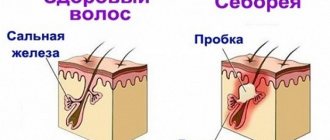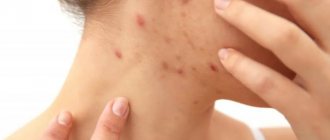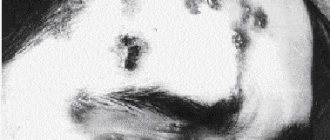Redness on the skin is a very unpleasant phenomenon for both adults and children. As a rule, they cause itching and flaking, which are sometimes accompanied by painful sensations. In addition, in each case, red spots look aesthetically unpleasant and repulsive. It is not surprising that every person strives to get rid of them as quickly as possible. And to do this, first of all, you need to understand the reasons for their occurrence, which can be very different. Moreover, sometimes redness on the skin indicates a very serious disease, including internal organs.
COST OF DERMATOLOGIST SERVICES IN OUR CLINIC IN ST. PETERSBURG
| Dermoscopy price | from 200 rub. |
| Dermatologist appointment | 1000 rub. |
| General blood analysis | from 160 rub. |
| Call free: 8-800-707-1560 *The clinic is licensed to provide urological services | |
What are the most common causes of red spots on the skin?
Allergic reaction
The content of the article
Taking certain medications, as well as consuming a number of vitamins and foods, interacting with pets, getting bacteria or dust mites on the skin, inhaling pollen from flowering plants, etc., can trigger an allergic reaction. Most often, it manifests itself in the appearance of red spots scattered over the body and causing severe itching, which in particularly difficult cases can lead to Quincke's edema and even death.
In such a case, you will need to consult a dermatologist, who will identify the cause of the allergy and prescribe appropriate treatment. Eliminating provoking factors, using histamine blockers and local ointments will allow you to quickly forget about the problem and avoid complications.
Types of hand allergies
Hand allergies mean a group of skin diseases, 20% of which are allergic dermatoses.[4] This type of skin pathology manifests itself at different ages, affects mainly older people, but can also begin in childhood as a sign of predisposition to dermatitis. Manifestations of allergies on the hands are typical for:
- atopic dermatitis (neurodermatitis);
- hives;
- contact dermatitis;
- eczema.
Each disease looks different. They also differ in duration of course, tendency to exacerbations and relapses. As a rule, the skin manifestations of atopic dermatitis and eczema persist for quite a long time, while urticaria and contact dermatitis are acute.[4] If you do not get rid of the external factors that triggered the allergy, the diseases will recur and eventually become chronic.
Presence of an infectious or venereal disease
The “culprit” of red spots is often the viruses of scarlet fever, rubella, measles, chickenpox and other infectious diseases. This also includes the disease syphilis, which manifests itself as red rashes on the skin.
The danger of such diseases is that a person not only experiences discomfort (the appearance of a red rash all over the body in these cases is usually accompanied by fever, chills and other unpleasant symptoms), but also turns into a carrier of the virus. Therefore, at the first signs of an infectious or sexually transmitted disease, accompanied by redness on the skin, you need to consult a doctor and begin comprehensive treatment, including taking antibiotics, antihistamines, vitamins, topical ointments - this is the only way to protect others and quickly cope with the disease.
Medical correction of red moles
The doctor, after conducting an initial examination and the necessary diagnostic measures, will make a conclusion regarding the likelihood of malignancy of the red mole. Based on this diagnosis, a strategy for further therapeutic actions is developed. If a red mole does not pose an oncological threat and is located in a closed area of the body, its removal is not necessary.
In cases where the red nevus causes aesthetic or physiological discomfort to the patient, it can be removed using modern hardware techniques, the priority among which is laser destruction. This method of removing red moles guarantees painlessness and safety for the patient, and also has a low level of trauma.
Medical offers its patients the latest expert-class medical equipment that meets the most stringent European standards. Effective therapy, high-quality medical service and affordable prices are the main principles of our clinic.
Find out the cost of the procedure “Removal of tumors”
Dermatological problems
The most common dermatological disease, characterized by the appearance of red spots - they are located locally or throughout the body - lichen. Experts distinguish several types of lichen, each of which has its own characteristics.
Red flat and ringing, scaly (psoriasis) and shingles, pityriasis and weeping (eczema) - all of them require the mandatory intervention of a specialist who can make a correct diagnosis and timely prescribe therapeutic measures. In addition, some types of lichen are transmitted by contact, which requires isolation of the patient from others, compliance with a special lifestyle, and exclusion of provoking factors.
Pathologies of the cardiovascular system and the consequences of frequent or constant stress and nervous tension.
The human body is a complex system in which everything is interconnected. Therefore, you shouldn’t be surprised if one of the consequences of nervous overstrain is redness of the skin (it’s not for nothing that people came up with the expression: “stains from nerves”). The reason for this phenomenon most often lies in vegetative-vascular dystonia, leading to impaired blood flow.
Redness of the skin will most likely not cause any pain and will go away on its own in a couple of days. However, you need to remember that quite serious diseases of internal organs can also lead to the appearance of spots: the cardiovascular system, gastrointestinal tract, etc. Therefore, any change in the skin should be a reason to contact a skin specialist.
Types of pigment spots and methods for their removal
Pigment spots can be small, large, single or multiple. They can have different shapes, usually close to oval, and different colors from light red to dark brown. The most common age spots are freckles, birthmarks and age-related pigmentation.
Freckles. This type of pigmentation is characteristic of fair-skinned people. Freckles usually appear on exposed areas of the body - the face, arms, ears, upper back and chest. Their color changes depending on the intensity of the sun. It is believed that freckles are caused by an uneven distribution of pigment in the skin, so over time, when the body gets stronger and adapts, they fade or disappear completely. For many girls, especially red-haired ones, freckles suit them - they add individuality, but this is not always the case. Too contrasting and extensive pigmentation is a reason for complexes, so they are “taken out”.
There are different ways to remove freckles. Traditional medicine, for example, recommends using parsley juice to whiten the skin. Of course, this method will not work immediately - it will take several months. Cosmetology offers much more effective methods. You can quickly remove freckles using chemical peeling with a base of fruit or lactic acids or laser skin resurfacing.
Birthmarks. Moles (nevi) can form on any part of the body. They have an even shape and a rather dark color. Unlike freckles, the melanin that forms the pigment spot is located in several layers of the skin, so removing a mole is more difficult than freckles. Moles have one peculiarity - they can degenerate into cancer, so large and suspicious formations are recommended to be removed. Birthmarks located in places of contact with the seams of clothing, belts and in areas subject to shaving are also removed. An injured mole is a gateway to infection: it can become inflamed, bleed and become wet.
A direct indication for contacting the clinic is a change in the shape, volume and color of the birthmark. Black and asymmetrical moles, bleeding or flaky spots with cracks are especially dangerous.
Moles without signs of cancer are removed with liquid nitrogen, diathermocoagulation or laser. Laser removal of birthmarks is most preferable, since it does not injure surrounding tissues and does not leave scars. And removing moles with a laser does not hurt at all, which is why many patients choose this particular technique.
Age spots. Unfortunately, these signs of impending old age cannot be prevented. Lentigo, as this type of pigmentation is called, appears in people after 40 years of age. Such age spots are especially noticeable during menopause, when pigmentation is spurred by hormonal changes. Lentigines, like freckles, are localized in places where the skin has been exposed to constant sunlight - on the face, arms, chest and back. Women, noticing such pigmentation, are upset, because they cannot hide the brown spots and they clearly show their age.
Age-related pigmentation can only be removed using cosmetic methods - traditional medicine will not help here. You can try medium or deep chemical peeling or low-impact laser removal. The advantage of the latter method is undeniable - after the procedure, only slight redness remains at the site of the spots, which quickly passes. With deep chemical peeling, the cosmetologist completely removes the top layer of skin, so recovery will take at least a month.
Large pigment spots. Melasma is a significant cosmetic problem. Unlike moles, such age spots have an uneven shape and look very unattractive. Their color intensifies in the sun - in spring and summer, and in winter the pigmentation decreases. Large pigment spots are a sign of hormonal changes, so they often occur during pregnancy, taking hormones, and the onset of menopause.
Large age spots can go away on their own, but women do not want to wait for this moment, so many resort to the help of a cosmetologist. Light peeling, special whitening masks, laser skin resurfacing, etc. can reduce the color of such spots.
What will an examination with a dermatologist give?
Since there are a great many causes of skin redness, it is not recommended to “remove” and treat them on your own. And here it doesn’t matter whether we are talking about small rashes scattered throughout or locally located large spots. Flaky and itchy or not causing much concern.
Only an experienced dermatologist will be able to determine the disease, sometimes by the nature and location of the redness. But even in this case, he will definitely prescribe a comprehensive examination, including analysis of scrapings from the affected areas of the skin, which will allow timely clarification of symptoms, the correct selection of treatment therapy, and possibly diagnosis of a very serious disease, which at first glance has nothing to do with the condition of the skin. covers.
Diagnostics
Diagnostic measures to identify the cause of a dermatological disease:
- Visual inspection. Based on the location and appearance of the inflammation, the doctor can make a preliminary diagnosis.
- Clinical blood test. The result of the analysis will show the presence or absence of an inflammatory process in the body, which can cause rashes.
- Allergological research. To diagnose allergies, the blood is examined for the presence of antibodies to allergens and the skin for reaction to irritants.
- Hormonal study. The content of thyroid and adrenal hormones, as well as sex hormones, is determined.
- Blood test for syphilis , AIDS, Hepatitis B and C.
- Examination of skin scrapings for fungus and mites.
- Blood and stool test for parasites.
A blood test is performed to check for the presence of parasites.
In case of immunodeficiency and HIV detection, an immunogram is performed - a comprehensive study of the human body’s immune system. For analysis, blood is taken from a vein.
If lupus is suspected, a blood and urine test, an X-ray of the joints and chest, an electrocardiogram, and an ultrasound of the digestive and excretory system are performed.
Literature:
- Werfel T., Breuer K., Rueff F et. Al. Usefulness of specific immunotherapy in patients with atopic dermatitis and allergic sensitization to house dust mites: a multi-centre, randomized, dose-response study. Allergy, 2006. - V. 61. - Issue 2. - P. 202-205.
- Clinical allergology. Guide for practicing doctors / ed. R.M. Khaitova. - M., 2002. - 624 p.
- Russian national conciliation document. Urticaria and angioedema. Recommendations for practicing physicians. — Ed. I.S. Gushchina, N.I. Ilyina. - M.: Farmarus Print Media, 2007. - 128 p.
- Instructions for medical use of the drug Cetrin®.
- Kareva E.N. Choosing an antihistamine: a pharmacologist’s view // RMJ. 2016. No. 12. pp. 811–816.
Contact dermatitis
A common allergic skin disease that occurs due to skin contact with allergens. It can occur in acute or chronic form. During an exacerbation, it manifests itself as redness of the skin and the formation of itchy blisters. In the chronic version, the skin becomes dry and the skin pattern intensifies2.
Allergens that can cause rashes include:
- metals (nickel, cobalt, chromium, aluminum);
- rubber and rubber products (balloons, latex gloves, condoms);
- cosmetics and perfumes (containing flavors, stabilizers, preservatives);
- local medications (anaesthetics, glucocorticosteroids, antibiotic ointments);
- Hair Dye;
- synthetic glue, adhesives;
- plants (primrose, poison ivy and others).
The development of dermatosis can occur through allergic or non-allergic pathways (irritant contact dermatitis). It is important to identify the substance causing the rash in time and avoid contact with it.
Preventive measures
In order not to look with disappointment at your reflection in the mirror and not to wonder how to get rid of allergies on your face once again, you should listen to the simple but effective advice of specialists.
- Adjust the daily menu by removing from the diet foods that provoke the appearance of characteristic symptoms of an immune disorder.
- Do not use cosmetics based on alcohol and other aggressive substances, giving preference to soft and neutral ones.
- Do not stay in the sun for a long time, and in winter, protect your skin from the cold as much as possible.
- During seasonal exacerbations of hay fever, use inhaled isotonic saline solutions to reduce the concentration of pollen in the nasopharynx.
- Always keep in your medicine cabinet an antihistamine recommended by an allergist-immunologist.
It is worth remembering that angioedema alone cannot be prevented. Other types of allergies are completely preventable, and this is much more effective than constantly treating exacerbations. Immunity support should take the leading place in the list of mandatory activities.
Treatment
It is not recommended to use drugs other than antihistamines on your own. In most cases, they are enough to eliminate the main symptoms and relieve swelling. It is necessary to take into account that the action must be comprehensive and must include creams, ointments and gels to relieve external signs of the disease.
Preparations for internal use
Medicines prescribed by a doctor are divided into corticosteroid and non-hormonal. The first are produced on a hormonal basis, have a powerful effect, but have a number of serious contraindications for long-term use. The second, milder ones, are prescribed to relieve mild forms of irritation. Several generations of antihistamines are available in pharmacies. If the former, such as Suprastin, influenced the level of attention, causing drowsiness and inhibition of reactions, then Cetrin, Telfast, Claritin, with high efficiency, do not give side effects that could become a limitation for work in areas where concentration is required.
Cosmeceuticals and their help in the fight against allergies
When the body reacts violently to a stimulus, skin lesions are sure to appear, and sometimes quite unpleasant ones. These are not only rashes and pimples, but also increased dryness and microcracks. Their danger lies in the possible entry of bacteria and the development of local inflammation. The main task, along with eliminating illness, is strengthening the immune system. Cosmetic products from the medical corporation "RHANA" are used in professional problem solving, provide a quick and lasting positive effect, allowing you to maintain beauty, health and prevent premature aging. And the skin is susceptible to it if an allergic reaction often appears on the face, a photo of which clearly demonstrates the degree of damage to the integument.
In order to give a fresh look and ensure cellular renewal, it is recommended to use placental preparations:
- Modeling mask with placenta hydrolyzate GHC Placental 3D Mask withQ10. It will prevent the risk of developing inflammation and give a healthy tone.
- Concentrate serum for intensive revitalization GHC Essence will instantly restore inner radiance, and also improve microcirculation and cell nutrition.
- LNC Repairing Cream with a moisturizing effect will preserve the beauty and freshness of the skin, and also protect it from moisture loss and eliminate the regeneration of ceramides (epidermal cells).
- Placental antioxidant lotion concentrate LNC Toning Lotion will protect cells, normalize melanin production and provide optimal hydration.
The dangers of self-medication
According to preliminary forecasts, the number of people reacting to certain stimuli will reach almost 90% by the end of the century. Allergists-immunologists mention the fault of allergy sufferers themselves, who, by self-medicating, expand the range of allergens and provoke the development of other diseases. In this case, the part is fixed and passed on by inheritance. By identifying the cause and drawing up an optimal treatment regimen, you can almost completely eliminate the likelihood of regular exacerbation of allergies.









